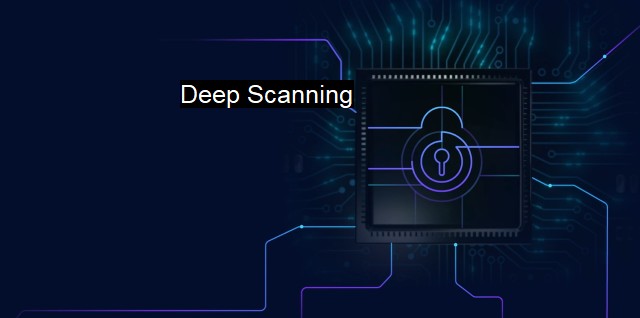What is Deep Scanning?
The Power of Deep Scanning in Cybersecurity: Exploring the Advantages and Limitations of this Powerful Antivirus Technique
Deep scanning, in the context of cybersecurity and antivirus solutions, refers to a detailed and thorough surveillance mechanism employed by antivirus software to investigate and secure every nook and cranny of a computer system. While traditional and more superficial antivirus measures only monitor the explicit operational areas of a computer for malicious activity, deep scanning probes more extensively, encompassing hidden, encrypted, and unknown regions.To crystallize the concept of deep scanning effectively, it would be ideal to first delve into the conventional precepts of antivirus software, a tool designed to detect, prevent, and remove malware. It operates mainly by enforcing preventative measures that shield devices from invasions by malicious applications: identifying known malware types, predicting suspicious behaviour, and acting as barricade to obstruct novel and complex malware varieties from infiltrating systems.
A significant limitation of standard, superficial antivirus activities, also known as quick scans, is their tendency only to survey the surface area of a device or network. These scans concentrate mostly on the registry area of a computer and other active user applications. While this aspect isn't entirely devoid of benefits, as it typically guarantees shorter scanning times and minimal energy consumption, it has significant drawbacks. Among these is the fact that many modern strains of malware are intricate and can often breach this preliminary barrier effortlessly.
Cue into the scene, deep scanning. This tool goes beyond the perimeter defense system that a quick scan provides, venturing into the entirety of the hard drive and all its layers. When conducting a deep scan, an antivirus software takes an in-depth route and attempts to verify the integrity of each single entity present within the hard drive – every application, software, files, and even the complex coded structures are placed under intense scrutiny.
This ensures nothing is left to chance, as it successfully uncovers dormant pieces of malicious software that may be lying inactive within the smaller crevices of a system. Deep scanning can prove particularly effective in locating rootkits – stealthy and dangerous forms of malware that evade the detection barrier of quick scans and effectively alter the very system functions and kernel operations of a computer.
It's crucial to mention that while deep scans are tremendously critical for maintaining robust cybersecurity, they are not without their downsides. Notably, they are considerably more time-consuming and energy-intensive when compared to their quick scan counterparts but in many instances, the compromise could be worthwhile.
There is also the risk of so-called "false positives". It means that an antivirus application might falsely label a legitimate software or file as a risk during a deep scan due to the strong detection efforts. This can usually be mitigated with regular software updates.
One should also survey whether regularly scheduled deep scans are efficient versus initiated on an as-needed basis. While routine deep scans certainly add an additional layer of security, they could interfere with response time and essential operations, thereby potentially impeding productivity.
Deep scanning is a critical tool within the field of cybersecurity and antivirus programming. It enables the unprecedented detection and quarantine of high-level threats, thereby augmenting system integrity and data safety. Equipping your cybersecurity toolkit with antivirus software which has deep scanning functionality is therefore crucial as we face a proliferation of more complex cybersecurity threats. Despite some downsides, their adaptability and all-encompassing surveillance capabilities are certainly instrumental in our epoch. Their usage must be aligned strategically with other device operations for optimal use and functioning. To get the most from these tools, integrating them into an overall cybersecurity approach that suit your unique requirements is key.

Deep Scanning FAQs
What is deep scanning in cybersecurity?
Deep scanning is a comprehensive scanning process that examines all aspects of a system for indications of digital threats. It is a thorough and time-consuming technique designed to identify vulnerabilities that may not be detected by conventional antivirus scans.What are the benefits of deep scanning?
Deep scanning can detect even the most sophisticated forms of malware that may be missed by traditional antivirus programs. The technique provides organizations with a comprehensive report on the state of their cybersecurity, allowing them to identify and fix any vulnerabilities that may have been missed. This helps to prevent potential cyber attacks and data breaches.How does deep scanning differ from traditional antivirus scanning?
Unlike traditional antivirus scanning, which only scans specific file locations or directories, deep scanning examines every file and program on a system. This includes hidden files, system files, and directories that may be overlooked by traditional antivirus programs. Deep scanning is designed to identify and eradicate malware, viruses, and other digital threats that may be lurking within a system.Is deep scanning necessary for all organizations?
Deep scanning is beneficial for all organizations, particularly those that handle sensitive information, such as financial data or personal information. It is also important for organizations that have experienced a cyber attack or have reason to believe that their systems may have been compromised. While deep scanning is time-consuming and resource-intensive, the potential cost of a breach can far outweigh the cost of a deep scanning process.| | A | | | B | | | C | | | D | | | E | | | F | | | G | | | H | | | I | | | J | | | K | | | L | | | M | |
| | N | | | O | | | P | | | Q | | | R | | | S | | | T | | | U | | | V | | | W | | | X | | | Y | | | Z | |
| | 1 | | | 2 | | | 3 | | | 4 | | | 7 | | | 8 | | |||||||